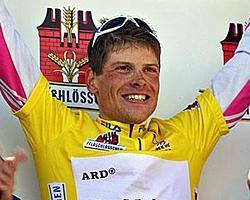
Recently on Cyclingnews.com |
69th Tour de Suisse - PT
Switzerland, June 11-19, 2005
A nasty, nasty way to end a bike race
Preview by Anthony Tan in Vevey, Switzerland

|
If the field currently riding the Dauphiné Libéré looks deep, the 2005 Tour de Suisse provisional line-up is also one of the strongest in years, in no small part due to the advent of the ProTour.
Expected to be on the start line this Saturday, June 11, is a former Tour de France winner and the defending TdS champion (Jan Ullrich), a two-time winner of the Giro d'Italia (Gilberto Simoni), a two-time winner of the points competition at the Tour (Robbie McEwen), this year's Tour of Flanders and Paris-Roubaix champ (Tom Boonen), and a host of contenders for the general classification at the world's biggest bike race.
Sure, most, if not all these drawcards are using the Tour de Suisse as their final race prep. for July - no argument there. But being so close to the Tour, these riders will want to test themselves, and the only way to do that is to ride hard and race hard, at least for a few stages.
"Defending my title is not on my mind, this is all about a measured build-up to the Tour de France," said Ullrich. "These stages will give me a chance to test my climbing form. I want to show myself at the head of affairs on at least one or two stages."
Double Vuelta a España champion Roberto Heras, who is riding the Dauphiné Libéré, also inadvertently praised the quality of field at the Tour de Suisse, saying before his race was about to begin: "many will be absent [from the Dauphiné] this year because they preferred to go to the Tour de Suisse".
In fact, the race has always attracted a top-quality field, and reading out the list of past winners reads like a list of delegates at a UN summit, with no less than 13 nationalities represented. Interestingly, apart from four-time winner Pasquale Fornara (1952, '54, '57-58), there's been no dominant winner at the TdS in its 72-year history; no-one has won the race three times, and only eight riders have done the double, including Italian Fornara.
Last year's race went down to the wire, as Ullrich won the race by less than a second from local favourite Fabian Jeker on the final day's time trial in Lugano. This year, however, the format has changed, almost representing a mini-Giro d'Italia of sorts, but could prove equally thrilling, with arguably the hardest stage reserved for last.
Stage 1 is one for the sprinters: the 169.9 kilometre route's only obstacles are just two Cat. 4 climbs along, and if you're going to get dropped on one of those, you better look for another profession.
Unlike last year, the ITT makes a far earlier appearance in 2005, but like last year, the hardest part of the 36 kilometre contre la montre is at the start, gaining 124 metres of elevation in the first 3.3 kilometres; after that, it's time to whack the chain into the 11 cog and keep it turning all the way back to Weinfelden.
The third stage is interesting. It could be won in a breakaway, or it could split the GC, if the previous day's TT hasn't already done so. Beginning in Abtwil/Säntispark in the far northeast, the peloton gently winds its way east in Austria, but the Cat. 2 climb of Arlbergpass with its summit less than 10 kilometres from the finish will inevitably see a less than sizeable front group arrive in St.Anton am Arlberg. It also must be the stage with the most tunnels per kilometre, with six in the final 60 kilometres! Headlights on, chaps!
Attention turns back to the speedy sprinters or eager escapists the following two days. Stage 4 sees the race head west from Vaduz on the Swiss/Austrian border to Zürich, before ending 208.2 kilometres later in Bad Zurzach, while the next day cuts through the heart of Suisse, ending in the town of Altdorf on the southernmost tip of Lake Lucerne.
The sixth stage goes back into the mountains, and with the HC climb of Oberalp Pass, before finishing 158.7 kilometres later at the mountain village of Arosa, 1,739 metres above sea level, it's sure to do a little more than shake the classement - 'shatter' might be a more appropriate word by the end of the day.
Stage 7 from Einsiedeln to Lenk may not be quite as tough, but it is long and undulating, and teams will need to protect their GC riders as much as possible. Actually, it mightn't be a bad idea to send a few non-threatening team-mates up the road to mitigate the prospect of being attacked.
The penultimate stage held in the region of Romandie is one of the final chances for the contenders to have their say on the general classification, but the mountain-top finish to Verbier may not be quite long enough to prove decisive. Expect to see a small group of no more than 20 riders fighting out the finish.
A procession is no way to describe the final day of the '05 Tour de Suisse. Starting and finishing in Ulrichen (no relation to Jan), it is, at least on paper, the hardest stage of the tour. Three HC climbs - the first to Nufenen and the race's high point at 2,748 metres, the second climbing the Gotthard Pass (2,109m.) and the third ascending the Furka Pass (2,431m.) - all in the short space of 100.4 kilometres is simply a nasty, nasty way to end a bike race...
... although fabulous entertainment value for those watching or reading!
